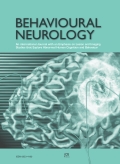Authors: Rogalski, E.J. | Murphy, C.M. | deToledo-Morrell, L. | Shah, R.C. | Moseley, M.E. | Bammer, R. | Stebbins, G.T.
Article Type:
Research Article
Abstract:
In the present study, changes in the parahippocampal white matter (PWM), in the region that includes the perforant path, were investigated, in vivo, in 14 individuals with amnestic mild cognitive impairment (aMCI) compared to 14 elderly controls with no cognitive impairment (NCI). For this purpose, (1) volumetry; (2) diffusion tensor imaging (DTI) derived measures of mean diffusivity (MD) and fractional anisotropy (FA); and (3) tractography were used. In addition, regression models were utilized to examine
…the association of PWM measurements with memory decline. The results from this study confirm previous findings in our laboratory and others, showing that compared to controls, individuals with aMCI have PWM volume loss. In addition to volume reduction, participants with aMCI demonstrated a significant increase in MD, but no difference in FA, both in the PWM region and in fibers modeled to pass through the PWM region. Further, the DTI metric of MD was associated with declarative memory performance, suggesting it may be a sensitive marker for memory dysfunction. These results indicate that there is general tissue loss and degradation (decreased volume; increased MD) in individuals with aMCI compared to older people with normal cognitive function. However, the microstructural organization of remaining fibers, as determined by measures of anisotropic diffusion, is not significantly different from that of controls.
Show more
Keywords: MRI, dementia, perforant path, tractography, entorhinal cortex, magnetic resonance imaging, hippocampus, memory, mesial temporal lobe, volumetry
DOI: 10.3233/BEN-2009-0235
Citation: Behavioural Neurology,
vol. 21, no. 1-2, pp. 51-61, 2009
Price: EUR 27.50





